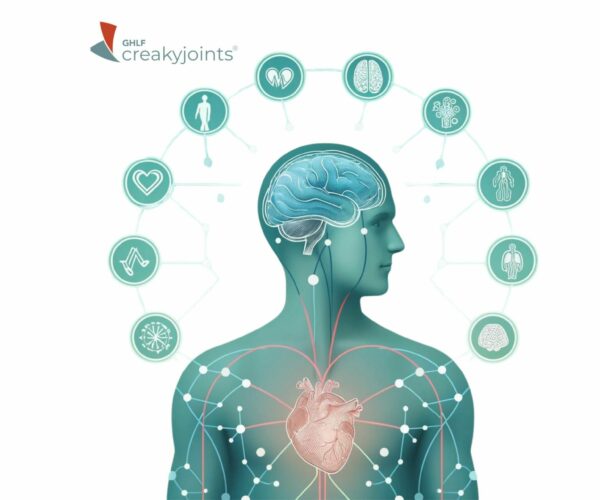“It’s almost like they’re connected,” my psychiatrist says with a playful smile. We had been talking about my depression symptoms and how they seemed to improve as my physical health got better. Or maybe it is the other way around — that my physical health was improving, and along with it, my depression. I nodded back at her, agreeing that my mental and physical health are intertwined.
It can be hard, though, to take this approach and see the ways our symptoms interact and play together. Our medical system breaks our body and mind into pieces — directing us to different doctors for each issue — one doctor for muscles aches, another for joints, and yet another (or two) for mental health.
Despite how our medical system is set up, this isn’t how our bodies work. We aren’t separated into sections like the game “Operation,” where you can fix things by focusing on just one part at a time. Fix this bone. Now, fix this broken heart.
For many years, I was fully immersed in the medical system, trying to dissect myself into pieces to heal individually. I thought that if I could heal each individual piece, I would feel better overall.
Dissected Into Parts
One of my diagnoses is psychogenic non-epileptic seizures (PNES). This is a condition caused by mental or emotional factors — in my case, a history of trauma leading to complex post-traumatic stress disorder (c-PTSD) — triggers seizure-like episodes. However, these episodes don’t involve the same brain activity as epileptic seizures and thus can’t be treated with epilepsy medications. When certain things trigger me or I experience intense somatic flashbacks, I often have one of these episodes.
When I first became ill, these episodes happened multiple times a month. I was unable to drive and struggled with daily living activities.
It took several years for doctors to diagnose this condition. My first neurologist thought it was tremors. Another doctor thought my muscles were fatigued from fibromyalgia. My second neurologist thought there may be something going on like multiple sclerosis. Finally, after a lot of testing and trial and error of medications, it was discovered the I was experiencing PNES, a form of a conversion disorder where mental or emotional factors cause physical symptoms.
As soon as I received this diagnosis, my medical doctors shrugged their shoulders. “There’s nothing I can do,” my neurologist told me. “This is a mental health condition.” However, my psychiatrist wasn’t much more help. “Shouldn’t you be talking to your neurologist about this?” she asked.
At the same time, I was seeing a rheumatologist for ankylosing spondylitis, a primary care doctor for fibromyalgia, a physical therapist, a pain specialist, an ophthalmologist for uveitis, a neurologist for chronic intractable migraine, and a counselor. I felt torn between multiple health care professionals telling me multiple things — each of them seeing only a part of me and none of them seeing me as a whole.
Putting Together the Pieces
As many of us with chronic conditions — whether physical, mental or both — know, we often have to be our own best advocate. After all, we know our bodies better than any medical professional or combination of professionals ever will. I realized that my doctors weren’t going to be much help, so I decided to dig into things on my own.
I began reading books like “The Body Keeps the Score” by Bessel van der Kolk and “Waking the Tiger” by Peter Levine. I started learning about how my physical symptoms and mental health symptoms are interrelated. I delved into information about how trauma could be affecting not just my PNES but also my autoimmune conditions and migraine.
As I read, I realized how interconnected all the things going on in my mind and body are. None of these issues — the trauma and resulting c-PTSD and PNES, the treatment-resistant depression, the migraine, the autoimmune conditions, the body pain, and fatigue — existed in isolation. They all existed in relation to each other and to me as a whole.
Once I began to see this, I was better able to approach treatment in ways that would benefit me. I knew I needed to do some serious work around my trauma to help my mental health and physical symptoms. I tried biofeedback to help manage my chronic pain, which also helped my anxiety. I began working with a pain psychologist who encouraged me to try tools and develop skills for pacing myself and managing my physical symptoms. Interestingly, as I implemented these strategies, my depression symptoms also began to improve.
One Body, One Mind
I couldn’t tell you if the improvement in my pain helped my depression or vice versa, or if my trauma work helped me manage my chronic physical conditions or if those improvements made it easier to focus on my trauma work. All I know is that they are all interconnected. I can no longer separate my mental health from my physical health, and I won’t do so any longer.
I am not made up of pieces that can be fixed independently, one at a time, in the hope of healing. Instead, I am an interconnected being, with parts that work together. I need to approach my health care and healing by seeing myself as a whole.
Be a More Proactive Patient with ArthritisPower
Join CreakyJoints’ patient-centered research registry to track your symptoms, disease activity, and medications — and share with your doctor. Sign up.






